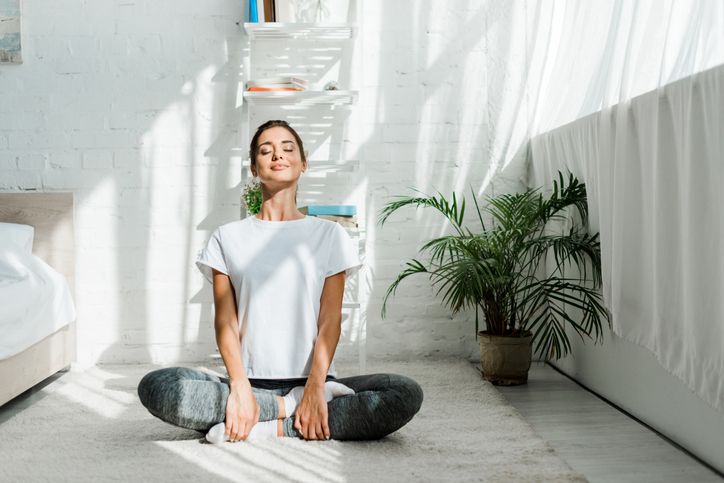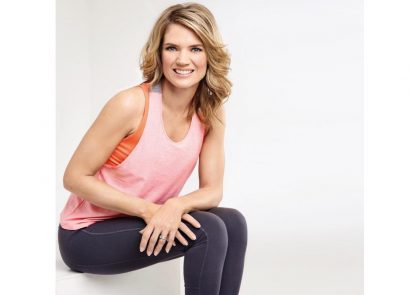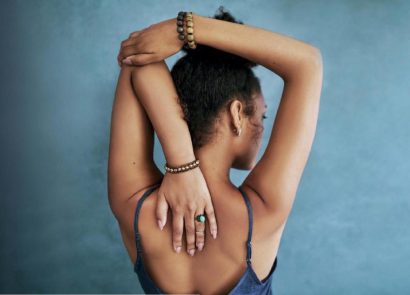Despite what it may seem, meditation isn’t just about sitting on the floor on a meditation cushion and closing your eyes, attempting to clear all thoughts from your mind. When done correctly, this mindfulness practice has many benefits, from lowering stress and lengthening your attention span, to improving your sleep and decreasing your anxiety levels. Some studies have even found that meditation reduced age-related memory loss.
Intrigued? Read on to find our easy tips and mindfulness techniques for beginners, to show you that anyone can become a meditator, even if they’re short on time. Prepare to say ‘om’!
How to meditate, and the benefits of meditation
With benefits including decreased stress, reduced anxiety, better sleep, increased happiness levels, boosted productivity and even a reduced chance of illness, meditation is a simple habit that is fast becoming a go-to health solution for those who feel stressed, menopausal or anxious.
“People are becoming increasingly aware of the benefits of meditation, and have realised that if they learn to meditate, it can help them better manage their daily life,” says meditation expert and founder of Inhere, Adiba Osmani. “Work stress and unexplained unhappiness are the major contributors of stress. Instead of simply being known as an ancient religious practice, recent scientific research is showing that meditation can help us navigate these modern difficulties.”
Once reserved for spiritual types, meditating has gone mainstream, and is enjoyed at a meditation class by busy mums, high-flying workers and stressed-out students suffering with anxiety alike. Those that are London-centric can get their fix at a meditation studio such as Inhere in the City. No time for classes? Download a meditation app such as Buddhify, the Calm app or Headspace, and zen out on-the-go.
What is meditation?
“Meditation is an approach to training your mind to focus and redirect your thoughts, but there are many techniques depending on your goal; whether that’s better sleep or stress management,” says Dominica Roszko, health and wellbeing expert and founder of vegerasta.com.
“Concentration meditation, for instance, involves focusing on a point like following the breath, repeating a single word or mantra, or staring at a candle flame. It’s very challenging for a beginner, so you would probably only be able to do one to three minutes in the beginning. Do it regularly and you will notice how your ability to concentrate improves.”
Types of meditation and meditation techniques
Sleep meditation
It can be hard to drift off into a peaceful sleep, but your sleep saviour may come from an unexpected source. We all know that the blue light emitted from your mobile phone isn’t conducive to a brilliant sleep, but if you’re using it to find a guided session of sleep meditation, an exception might just be made!
You can find plenty of long and short meditation videos online that you can use as a relaxation technique to help you sleep: there’s a whole range to choose from on Insight Timer or Headspace.
Transcendental meditation, Buddhist meditation and Hindu practices
Traditionally, meditation practice was seen as the preserve of Buddhist monks in their quest for enlightenment according to Buddhist teachings. However, over time, meditation has also been used in yoga practices such as transcendental meditation (TM), developed by Maharishi Mahesh Yogi which takes inspiration from Hinduism. The TM technique has become widely-known owing to its celebrity practitioners, and if you’d like to learn TM, the basics are quite simple.
You simply sit, with your eyes closed, repeating a silent mantra (word or phrase) of your choosing, for 20 minutes once or twice a day.
If you’re interested in developing this, you could try the chakra meditation technique, which also has a basis in Hinduism. This form of meditation targets ‘energy’ in certain parts of your body such as the heart chakra, third eye chakra, crown chakra, solar plexus chakra, throat chakra and root chakra.
Breathing meditation
You don’t need any special equipment to be able to meditate and do this breathing exercise, so you can begin today. “Start by deciding whether you want to set an alarm for a few minutes to end your meditation session, or if you’re happy to be still without a time restriction,” says Dani Binnington, yoga practitioner and wellbeing expert.
“Take a comfortable seat in a quiet place. Lift through the crown of your head, lengthen your spine, and sit tall. Close your eyes and scan your body from your head down to your feet. Name the body parts as you draw your attention towards them, and soften your shoulders, neck, jaw and cheeks in particular.
“As you’re sitting tall and relaxed, spend a few moments being still. Notice any sounds around you, any sensations in your body, any feelings of comfort or discomfort, and your mental chatter.
“There’s no need to judge, accept and take it all in. It often helps to prolong this experience by becoming more actively aware of your breathing technique. Expand your chest and belly when you inhale, and fully exhale as you draw out any stale air.
“Feel your spine lengthening as you breathe in, and, as you exhale, release any tension out of your shoulders. Your inhales and exhales are a constant exchange of energy.”
Mantra meditation
Dani says, “Sometimes it’s hard to just sit, breathe and do a mindful meditation because our minds rush here, there and everywhere. If so, it can help to talk yourself through what you’re doing.
“Try repeating a mantra (a word, sentence or sound) a few times. This can help you focus – you can say it out loud or silently to yourself. A simple mantra for beginners to say is ‘I am breathing in, I am breathing out’, or ‘I am healthy and feeling calm’.
“However, just because you’re sitting tall and focusing on your breathing practice or a mantra, it doesn’t mean that this stops you from having thoughts. Acknowledge them, set them aside and return back to your breath and mantra. Do this for every thought – don’t judge it, wish it away or dwell on it. Become aware of how busy your mind is on some days, and how much smoother this process is on other days.
“End your daily practice by slowly bringing your conscious attention back to your surroundings when your alarm rings, or when you naturally feel that you’ve finished. Spend a moment feeling grateful, then resume your day.”
Mindfulness meditation for anxiety
Dominica says: “During mindfulness meditation, you observe wandering thoughts as they drift through your mind. The intention is not to get involved with the thoughts or to judge them, but simply to be aware of each mental note as it arises.
“Through mindfulness meditation, you can see how your thoughts and feelings tend to move in particular patterns. Over time, you can become more aware of the human tendency to quickly judge an experience as good or bad, pleasant or unpleasant. With practise, an inner balance develops. The benefits are endless, and you will notice the difference as soon as you start meditating regularly.”
Yoga meditation to beat anxiety
How many of us have days when it all just seems too much? When we’re stressed, our body creates the stress hormone cortisol, and our muscles tighten and get ready to burst into action. If we stay in this stressed state, these natural responses can become a problem, but there are things you can do to get back into a state of calm. This is where yoga comes in!
The following short sequence from yoga teacher, reiki healer and holistic coach, Michelle Taylor starts with deep breathing to relax your brain, and then moves on to yoga poses to calm and restore. This makes a brilliant 10-minute meditation practice, which you can use alongside more conventional techniques, such as cognitive behavioral therapy, to reduce symptoms of stress.
Easy pose (sukhasana)
The best place to start for dealing with any type of stress or tension in the body is with your breath.
- Bring yourself into easy pose (a cross-legged position) by starting with your legs extended out in front of you, then crossing them at the shins. Think about lengthening up through the crown of your head to keep your spine long. Place one hand to your chest, the other to your belly, or rest your hands on your knees if it’s more comfortable.
- Close your eyes and start to concentrate on your breath. Start by simply noticing how you are breathing, whether it’s fast or slow, whether it’s into your chest or all the way into your stomach. Take this opportunity to check in with how you are feeling, both physically and mentally, without judgement.
- Starting from your head and working your way down the body, notice where you are feeling tension in your body. Focus on how you are feeling emotionally.
- Next, start to breathe a little deeper, creating an even inhale and exhale – you can count in your head – inhaling for a slow count of three or four, then out for the same. Draw the breath all the way down to your tummy. If your hand is on your chest and stomach, you should feel it travel down past your chest to your tummy and then back up.
Child’s pose (balasana)
This is a deeply restorative and calming pose. If you’re in the wide-legged version, you’re also stretching through your shoulders, which may feel tight when you’re stressed.
- Bend into your knees and bring yourself down to the floor to the centre of the mat on your hands and knees.
- Take your knees wide and bring your big toes together behind you. Sit back towards your heels, and fold forward with your head on the floor. Draw your attention to the point between your brows, where your forehead is in contact with the mat. Feel free to bring your knees together and wrap your arms around behind you, with your palms facing up if that’s more comfortable for you.
Corpse pose (savasana)
This pose will give you time to soak in the benefits of your practise and allow your body to fully relax.
- Come away from the wall or gently lift your hips to remove any props, then lie on your back with your legs extended, and your feet out towards the outer corners of the mat for the final resting pose. Let your arms rest beside you, slightly away from your body, with your palms facing upwards. Allow yourself to take up some space, and let your breath settle into its natural pattern.
- Close your eyes, soften your jaw, and scan from the top of your head down like you did at the start, relaxing everything that you can, and allowing yourself to feel heavy on the mat.
- Come out slowly, starting with a little movement to your fingers and toes, rolling your head from side to side, moving on to circling your wrists and ankles, and then taking a big, full-body stretch before rolling onto your side and easing yourself back up to a seated position from there. Keep your eyes closed if possible.
- Bring your hands into prayer position at your heart, drawing attention to your heart and noticing if there has been any change to how you were feeling from the start of your meditation practice. Take a deep breath in through your nose and out of your mouth. Gently blink your eyes open.
Meditation for beginners
Morning unguided meditation practice
“After you switch off your alarm in the morning, sit up straight on the edge of your bed with your feet flat on the floor,” says mindfulness coach Justine Curlis.
“Stop, breathe, and take a moment to examine your thoughts without judging them or getting into a conversation with them. Notice how you’re feeling. Finish by bringing your attention to feeling the rise and fall of your next 10 breaths, before getting on with your day.”
Five-minute meditation
The following easy meditation comes from author, life coach and ballroom dancer, Camilla Sacre-Dallerup: “One of the most magical things meditation has taught me is the feeling of returning home within, and I love sharing this with my clients and students. We get caught up in our own thinking and, often, this can disconnect our mind and body, causing more stress. We let our logical mind rule our lives, and stop listening to the signals our body is giving us – powering through when we need to rest.
“Unfortunately, it often takes feeling stuck or unwell to make us realise that it’s time to connect with the guidance we are feeling in our bodies, especially our hearts and gut. Here’s a meditation to try if you are feeling out of balance and in need of reconnection with your inner self.”
- Sit somewhere relaxing and place one hand on your heart and the other hand on your belly.
- Take a few deep breaths, focusing on how the breath is flowing through your entire body.
- Imagine a bright light slowly flowing down through your body, from the top of your head to the tip of your toes.
- As you connect with the light flowing through you, allow yourself to tune in to how your body is feeling. As the light flows down, if you notice you are holding any tension in the body, ask yourself what it’s representing and then let it go.
- When you catch yourself thinking, simply return to how your body is feeling, and mentally repeat the words ‘I am returning home within and I am listening’ with each breath.
20-second calm meditation soothers
1. Plug your headphones in
“Listening to relaxing meditation music, especially slow, quiet classical music, can have a positive affect on our bodies’ physiological functions,” says Dr Rupert Critchley from Viva Medical Clinics. “It decreases stress hormones, while also lowering the heart rate and blood pressure.”
2. Check in with your breath
Becoming aware of the physical, rhythmic sensations of your breath switches on the relaxation response. If your breath is tight or shallow, gently place a hand on your abdomen and feel your breath rising and falling against your resting palm.
3. Self-massage
“Lean back in your chair and use two fingers to massage the point where the neck meets the skull for 20 seconds,” says Dr Critchley. “The skull is a hot-bed full of pressure points, so massaging it can reduce stress levels.”
Nine-hour guided meditation session
7am: Morning meditation to get set for the day
“Finding time to meditate is difficult for all of us. Let’s face it – life is busy. There’s an old saying that claims if you can’t find 10 minutes in your day to meditate, you probably need 20 minutes,” says Dr Megan Jones Bell, chief science officer at guided meditation app Headspace.
“As a mum, I find that if I get up a little bit earlier than my one-year-old I can fit in my daily meditation practice, and it sets my day off in the right direction.”
7:30am: Have a meditative power shower
“If you feel too busy to meditate, try meditating in the shower – it’s already part of your day, so no extra time is required,” says Christian Slomka, community manager at mindfulness app Calm. “Often, the mind is tangled up in a mess of past regrets, worries about the future and demanding to-do lists. So, instead of giving your attention to those thoughts (you likely already give them more than enough time), shift your awareness to the sensation of showering.
“If you get distracted by your thoughts, don’t worry, that’s normal. Your job is to kindly invite yourself back to your breathing, the sound of the running water, the scent of your soap, the temperature, and the feeling of massaging your scalp with shampoo. Spending time in the present moment like this will help you to develop the ability to concentrate when you need to focus, settle your mind when you need rest, expand your perspective and tune into the wisdom within.”
8am: A mindful breakfast
“Just take a moment to stop and notice where you are right now. Engage your senses one at a time,” says meditation teacher Sarah Presley.
“What can you taste? How about your sense of smell? What can you see around you? Do you hear anything? Congratulations! You have just been completely in the present moment.”
8:30am: Your mindful commute
When you sit down on the bus, tube or train, direct your attention to all the various sounds around you,” says Anna Wikfalk, mindfulness expert at The Mindfulness App. “There’s no need to judge or evaluate the sounds. Instead, see if you can be curious about the different qualities of the noises – high or low, sharp or soft, and so on. Just rest in the landscape of sounds.”
9am: Grounding yourself
“One of the quickest and most effective mindfulness hacks is to consciously feel the sensations of contact between the soles of your feet and the ground,” says meditation teacher Maggie Richards, author of A Guide to Being a Better Being. “Be curious about this one aspect of your present moment. You should soon find yourself feeling more grounded and clear-headed. Practise this often throughout the day, whether sitting, standing or walking, and you’ll enjoy new levels of clarity and calm.”
12pm: Body awareness meditation
“The best way to start unplugging is to try it now as you sit reading this article!” says Rohan Gunatillake, creator of Buddhify mindfulness app. “If, as you read this, you can be aware of any tension in your body or how your hands feel, you are already starting to practise. This is known as body awareness, and it develops sensitivity, balance and stability.
“Start noticing people and send them kind thoughts. Wish them well with a loving kindness meditation (also known as metta meditation) mantra such as ‘may you be well, may you be happy’. This helps us take time away from our own personal storyline.”
4pm: Soothe work stress
Difficult day? Left to its own devices, your lower or ‘monkey mind’ is generally negative – you might walk away from work thinking ‘he talked too loudly’, ‘she wasn’t helpful’, ‘I’m tired’, and so on. Yet, you have a choice.
“Get stressed by your stress or empower yourself with positive thoughts,” says Richards. “Look for the good in and around you. Try it now.
“Notice the comfort of your seat, someone’s beautiful smile, a colourful pair of shoes or the blue sky above. Now, notice how with time your inner world starts to lighten and relax. One simple switch in attitude, practised regularly, can really lift your day.”
Meditation apps, retreats, books and videos
The best meditation apps
Buddhify
This app offers a range of easy mindful soothers you can do when running, at work, commuting, eating, exercising at the gym and much more.
Best bit: There’s a single fee for all meditation content, rather than an expensive monthly subscription.
Buy: £4.99 on iOS or £2.99 on Android.
Calm
This is a handy meditation and mental wellness app, which includes 21-day and week-long programmes, relaxing music, sleep stories and nature sounds.
Best bit: The Calm Masterclasses on mental health and wellbeing subjects are delivered by world-renowned experts.
Buy: Free to download on iOS/Android, but paid subscription for premium content.
Headspace
Former Buddhist monk, Andy Puddicombe, is the voice of this British guided meditation app, which boasts different ‘packs’ for sleep, stress, kids, work and more.
Best bit: The variety. There’s a range of tried and tested techniques to help you meditate, including body scans, noting and visualisations.
Buy: Free to download on iOS/Android, but paid subscription for premium content.
The Mindfulness App
This app offers meditations with world-renowned teachers in an accessible format.
Best bit: Its reminder function, which can be activated at specific times and places so you never forget to breathe!
Buy: Free to download on iOS/Android, but paid subscription for premium content.
Smiling Mind
This easy-to-navigate app features a library packed with meditations suitable for people of all ages – you can pick and choose your own programme and go at your own pace.
Best bit: It’s 100 percent not-for-profit, so all of the content is free to use.
Buy: Free to download on iOS/Android.
Three UK meditation retreats
If you feel like escaping it all, we can’t think of anywhere better than these relaxing retreats!
Gaia House for Buddhist meditation
Set in the peaceful beauty of the South Devon countryside, press pause on everyday life with silent zen meditation retreats guided by experienced Dharma teachers from all over the world.
A Place to Heal by Arrigo
If you’re after a one-day meditation course, consider A Place to Heal in London’s Holland Park. Relax in the beautiful plush interiors and forget the world outside.
Yoga at the Mill
For a weekend of mindfulness, look no further than this restorative retreat in the Norfolk countryside.
Three mindfulness and meditation books
Breath: The New Science of a Lost Art by James Nestor
As breathing practices become increasingly popular, delve into the science behind our breathing with this revelatory book.
The Wild Journal by Willow Crossey
Harness the beauty of the natural world around you, and feel more grounded with Willow Crossley’s inspirational words.
The Art of Happiness by The Dalai Lama
An absolute classic, this book of teachings on happiness is sure to uplift your spirits. Based on ancient Buddhist meditations and a heap of common sense, you’re sure to find answers to your difficulties.
Three meditation videos
Insight Timer Youtube
Enjoy a huge range of guided meditation, soothing music videos, affirmations and more with Insight Timer.
Headspace Youtube
With plenty of expert advice and some rather cute and humorous cartoons, you’ll be in a better place in no time with Headspace.
Inner Space
The website of meditation and personal development centre, Inner Space, is a brilliant resource full of guided meditations.




















